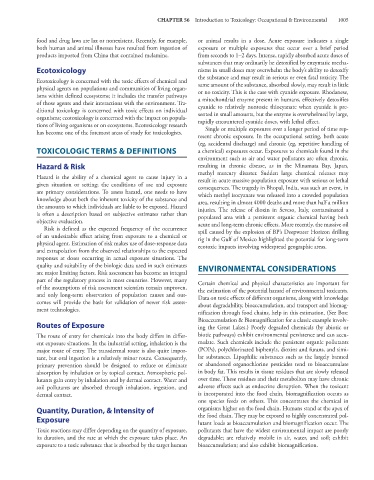Page 1019 - Basic _ Clinical Pharmacology ( PDFDrive )
P. 1019
CHAPTER 56 Introduction to Toxicology: Occupational & Environmental 1005
food and drug laws are lax or nonexistent. Recently, for example, or animal results in a dose. Acute exposure indicates a single
both human and animal illnesses have resulted from ingestion of exposure or multiple exposures that occur over a brief period
products imported from China that contained melamine. from seconds to 1–2 days. Intense, rapidly absorbed acute doses of
substances that may ordinarily be detoxified by enzymatic mecha-
Ecotoxicology nisms in small doses may overwhelm the body’s ability to detoxify
the substance and may result in serious or even fatal toxicity. The
Ecotoxicology is concerned with the toxic effects of chemical and same amount of the substance, absorbed slowly, may result in little
physical agents on populations and communities of living organ- or no toxicity. This is the case with cyanide exposure. Rhodanese,
isms within defined ecosystems; it includes the transfer pathways a mitochondrial enzyme present in humans, effectively detoxifies
of those agents and their interactions with the environment. Tra- cyanide to relatively nontoxic thiocyanate when cyanide is pre-
ditional toxicology is concerned with toxic effects on individual sented in small amounts, but the enzyme is overwhelmed by large,
organisms; ecotoxicology is concerned with the impact on popula- rapidly encountered cyanide doses, with lethal effect.
tions of living organisms or on ecosystems. Ecotoxicology research Single or multiple exposures over a longer period of time rep-
has become one of the foremost areas of study for toxicologists.
resent chronic exposure. In the occupational setting, both acute
(eg, accidental discharge) and chronic (eg, repetitive handling of
TOXICOLOGIC TERMS & DEFINITIONS a chemical) exposures occur. Exposures to chemicals found in the
environment such as air and water pollutants are often chronic,
Hazard & Risk resulting in chronic disease, as in the Minamata Bay, Japan,
methyl mercury disaster. Sudden large chemical releases may
Hazard is the ability of a chemical agent to cause injury in a result in acute massive population exposure with serious or lethal
given situation or setting; the conditions of use and exposure consequences. The tragedy in Bhopal, India, was such an event, in
are primary considerations. To assess hazard, one needs to have which methyl isocyanate was released into a crowded population
knowledge about both the inherent toxicity of the substance and area, resulting in almost 4000 deaths and more than half a million
the amounts to which individuals are liable to be exposed. Hazard injuries. The release of dioxin in Seveso, Italy, contaminated a
is often a description based on subjective estimates rather than populated area with a persistent organic chemical having both
objective evaluation. acute and long-term chronic effects. More recently, the massive oil
Risk is defined as the expected frequency of the occurrence spill caused by the explosion of BP’s Deepwater Horizon drilling
of an undesirable effect arising from exposure to a chemical or rig in the Gulf of Mexico highlighted the potential for long-term
physical agent. Estimation of risk makes use of dose-response data ecotoxic impacts involving widespread geographic areas.
and extrapolation from the observed relationships to the expected
responses at doses occurring in actual exposure situations. The
quality and suitability of the biologic data used in such estimates ENVIRONMENTAL CONSIDERATIONS
are major limiting factors. Risk assessment has become an integral
part of the regulatory process in most countries. However, many Certain chemical and physical characteristics are important for
of the assumptions of risk assessment scientists remain unproven, the estimation of the potential hazard of environmental toxicants.
and only long-term observation of population causes and out- Data on toxic effects of different organisms, along with knowledge
comes will provide the basis for validation of newer risk assess- about degradability, bioaccumulation, and transport and biomag-
ment technologies.
nification through food chains, help in this estimation. (See Box:
Bioaccumulation & Biomagnification for a classic example involv-
Routes of Exposure ing the Great Lakes.) Poorly degraded chemicals (by abiotic or
The route of entry for chemicals into the body differs in differ- biotic pathways) exhibit environmental persistence and can accu-
ent exposure situations. In the industrial setting, inhalation is the mulate. Such chemicals include the persistent organic pollutants
major route of entry. The transdermal route is also quite impor- (POPs), polychlorinated biphenyls, dioxins and furans, and simi-
tant, but oral ingestion is a relatively minor route. Consequently, lar substances. Lipophilic substances such as the largely banned
primary prevention should be designed to reduce or eliminate or abandoned organochlorine pesticides tend to bioaccumulate
absorption by inhalation or by topical contact. Atmospheric pol- in body fat. This results in tissue residues that are slowly released
lutants gain entry by inhalation and by dermal contact. Water and over time. These residues and their metabolites may have chronic
soil pollutants are absorbed through inhalation, ingestion, and adverse effects such as endocrine disruption. When the toxicant
dermal contact. is incorporated into the food chain, biomagnification occurs as
one species feeds on others. This concentrates the chemical in
Quantity, Duration, & Intensity of organisms higher on the food chain. Humans stand at the apex of
Exposure the food chain. They may be exposed to highly concentrated pol-
lutant loads as bioaccumulation and biomagnification occur. The
Toxic reactions may differ depending on the quantity of exposure, pollutants that have the widest environmental impact are poorly
its duration, and the rate at which the exposure takes place. An degradable; are relatively mobile in air, water, and soil; exhibit
exposure to a toxic substance that is absorbed by the target human bioaccumulation; and also exhibit biomagnification.

